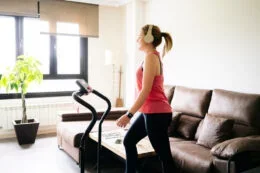What is RPE and How to Apply it to Treadmill Training
What is the RPE Scale?
Rate of Perceived Exertion (RPE) is an important concept in fitness that can help athletes and trainers to ensure that they are working at the right intensity level to meet their goals. RPE is a subjective measure of intensity on a scale from 1 to 10, with 1 being the least amount of effort and 10 being the maximum amount of effort. The scale is based on the individual’s perception of how hard they are working, so it is important that athletes and trainers understand how to use the RPE scale properly to ensure that they are working at an appropriate intensity level.
By using the RPE scale, athletes and trainers can monitor and adjust the intensity of an exercise to make sure that they are achieving the desired results. Knowing how to use the RPE scale can help to maximize the effectiveness of each workout and ensure that athletes and trainers are working to their full potential.
RPE is a useful tool that can help athletes and trainers to ensure that they are working at the right intensity level to meet their goals. By understanding how to use the RPE scale properly, athletes and trainers can monitor and adjust the intensity of their workouts to maximize their effectiveness.
How to Apply RPE to Treadmill Workouts
Begin your workout on the treadmill at a pace you consider low effort (perhaps an RPE of 2-3) and gradually increase the speed and incline until you reach a level of exertion that aligns with your exercise goals. For example, a moderate-intensity workout might hover around 4-6 on the RPE scale, feeling like you’re working, but can still hold a conversation. For a more vigorous workout, aim for an RPE of 7-8, where speaking full sentences becomes challenging. By regularly assessing and adjusting your effort according to your RPE, you can ensure your treadmill sessions are effectively aligned with your fitness objectives, whether it’s a light recovery day or a high-intensity interval training.
Over the course of a week, your RPE for treadmill training can and should vary, allowing for proper balance between intensity and recovery—crucial for preventing overtraining and enhancing overall fitness. Early in the week, you might target higher RPE levels (7-8) during workouts, focusing on intervals or hill training that challenge endurance and strength. As the body needs time to recover from these intense sessions, ensuing workouts could scale back to a moderate RPE (4-6), encouraging steady-state cardio that sustains heart rate without overwhelming fatigue.
Midweek could incorporate active recovery workouts, with RPE dropping to 2-3, using low-intensity walking or light jogging to facilitate muscle recovery while still promoting blood flow. Towards the end of the week, you might ramp up the RPE again for another high-intensity session if your fitness goals include improving performance, or you might opt to stay at a moderate level if you’re focused on maintaining general fitness or if you’re tapering for a race.
By week’s end, RPE might reduce as you give your body a chance to rest with a very light workout or complete rest, allowing for tissue repair and strength building. Ultimately, how RPE changes throughout the week will depend on individual training plans, goals, and personal recovery rates, so it is important to listen to your body and adjust RPE accordingly to optimize performance and health.
Other Treadmill Reviews:
- Amazon Big Spring Sale 2025 for Treadmills
- About: Brian Boyce
- Best Treadmills for Home
- Test HomePage
- NordicTrack Commercial X14i
- Echelon Stride
- NordicTrack C 590 Pro
- Sole TD80 Treadmill Desk
- NordicTrack Commercial X11i
- NordicTrack T 8.5 S - Pros & Cons (2025)
- Horizon Elite T5
- ProForm Pro 1000
- Exerpeutic TF1000
- NordicTrack T 6.5 S - Pros & Cons (2025)
- ProForm Sport 5.0
- ProForm Premier 900
- ProForm ZT6
- NordicTrack FreeStride Trainer FS5i (Discontinued)
- Bowflex Max Trainer M5
- BowFlex TreadClimber TC100
- ProForm Power 795
- ProForm Sport 7.0
- NordicTrack Incline Trainer X15i
- LifeSpan TR3000e Electric Folding
- NordicTrack C 1650 Treadmill
- Horizon Elite T9
- Official Boston Marathon Treadmill 4.0
- NordicTrack Treadmill Desk
- NordicTrack C 1630 Pro
- NordicTrack C 970 PRO
- Bowflex TC20 TreadClimber

